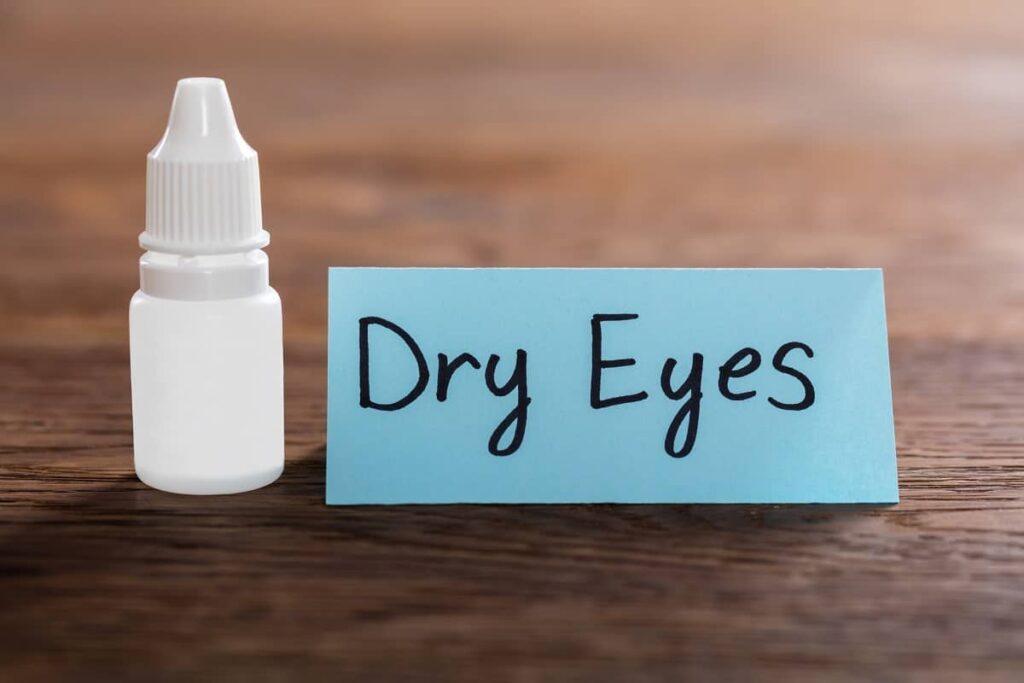
Dry eyes. Gritty, itchy, burning and uncomfortable eyes. Some patients even complain of tearing with dry eye because of the irritation. Sound familiar? Millions of people in the U.S. report dry eye symptoms, so it isn’t surprising that at some point, you might share in this unpleasant experience. Dry eyes are common and can become a chronic problem that poses risks to the health of the eye and, sometimes, can impact vision.
Now, more people than ever are experience dry eye symptoms by wearing masks to protect from COVID-19 and through more screen time with virtual environments. The good news is there are several treatment options available to provide some much needed relief.
What is Dry Eye?
Let’s start with a simple definition of dry eye. Dry eyes are a condition in which a person doesn’t have enough quality tears to lubricate and nourish the surface of the eye. While most relate tears as an expression of sadness or other strong emotion, tears serve several important functions for your eye and vision. Tears keep the eye moist, nourished and healthy when the eye is functioning properly. Plus, the film of tears that covers the surface of the eye and is constantly replenished by blinking, creates a pristine, smooth surface that helps provide clear vision.
In addition to tears lubricating the eye, they also reduce the risk of eye infection and protect the eye by washing away dust and debris that may get in the eye. Tears work to help keep the surface of the eyes smooth and clear, which is important to clear vision.
When the eye isn’t well lubricated by tears, that’s when the problems with dry eye symptoms start. When these symptoms become increasingly bothersome or chronic, you are likely dealing with dry eye syndrome.
Dry eyes (also know as dry eye syndrome) are the result of the eye’s inability to properly lubricate itself. This is due to one of two factors:
- Not enough tears are being produced
- Poor quality tears are being produced
There are several glands in and around the eyelids that produce the oil that is important in tears. These are called Meibomian glands. If those glands don’t work properly, or become plugged, tear production is affected. Tears are made up of three key ingredients: oil, water and mucus. When each of those ingredients are produced in the right amount and quality, tears do the job in keeping the eye well lubricated, smooth and healthy. Any imbalance in the levels of water, oil and mucus and problems emerge. The tears evaporate too quickly or don’t spread evenly across the surface of the eye, all of which can lead to dry eye symptoms.
What causes dry eyes?
But what causes dry eyes? Turns out, there are a lot of contributing factors:
- Age is a big one and, in fact, the majority of people over the age of 65 experience dry eye symptoms. Just like the rest of the body, certain eye functions diminish with age and dry eyes are a part of the natural aging process.
- Hormone changes or imbalances can also be a factor. Not surprisingly, therefore, women are more likely to experience dry eye symptoms due to the hormonal changes that occur in pregnancy and menopause as well as using oral contraceptives.
- Certain over-the-counter and prescription medications can impact tear production. These include everything from common cold and allergy medicines to prescription drugs used to treat high blood pressure and depression.
- Some chronic medical conditions can also lead to dry eye. It is not uncommon for people with rheumatoid arthritis, diabetes and thyroid problems to experience dry eye symptoms. Of course, eye infections, inflammation or other eyelid conditions can also cause dry eye problems.
- Certain environmental factors, like smoke, wind and dry climates can result in rapid tear evaporation and dry eye symptoms.
- Digital eye strain has become a significant issue in today’s tech-dependent society. Staring at phones and computer screens has been shown to dramatically reduce blink rate, which can lead to improper expression of the tear glands and contribute to dry, irritated eyes.
- Nutrition plays an important role in the quality of tears. Green vegetables and omega-3 triglycerides have been shown to play a major role in tear production.
- Your choice of vision correction may also be causing dry eye. People who wear contact lenses over a long period of time often report dry eye symptoms. And, some laser vision correction patients report dry eye symptoms during the healing process from procedures such as LASIK.
What can you do if you are struggling with dry eyes and tired of the irritation?
First – don’t ignore the signs or symptoms of dry eye. While it may seem like a small thing, you now know that your tears play an important role in the health of your eyes and vision. Make sure you schedule – and keep – your annual eye appointment and let your eye doctor know about any symptoms you are having so they can be evaluated and, if necessary, treated. And, if you are experiencing significant symptoms, don’t wait. Make the call and get in to see your eye doctor before any real damage is done. Ongoing dry eye conditions pose a real threat to the health of your cornea and treating it early and prevent progression.
In the meantime, there are a few things you can do that may help reduce the severity or frequency of your symptoms:
- Blink. Give your eyes the break they need and deserve and replenish that tear film layer. Be aware of your screen use and practice some self-care by blinking regularly to prevent eye problems.
- Buy a portable humidifier so you can control the level of humidity at home and at work, if necessary. Air conditioning can really sap the moisture out of the air. A portable humidifier can offer some relief, especially in the bedroom where you spend one-third of your life.
- Sunglasses, particularly wrap-around styles, can help block out wind – along with reducing damaging sun exposure.
- Staying hydrated is important, as is a balanced diet. Drink plenty of water throughout the day and look for ways to increase those foods rich in essential fatty acids and other eye-healthy nutrients in your daily diet.
Williamson Eye Center is pleased to be home of Lousiana’s only Dry Eye Center. With more advanced testing available at our Baton Rouge Bluebonnet dry eye clinic, we are able to customize a dry eye treatment plan to relieve your symptoms at the source. Schedule your dry eye evaluation today!



